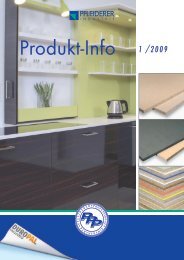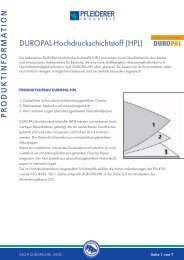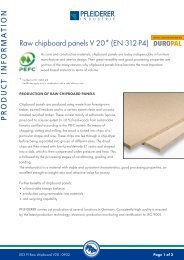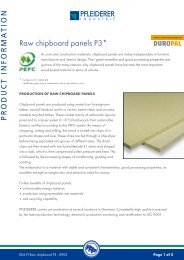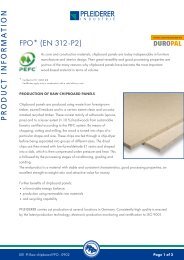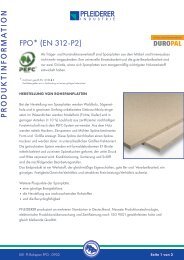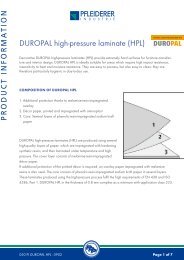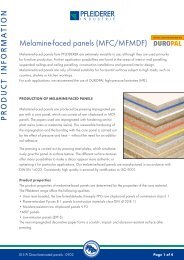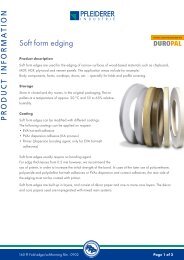Processing and working instructions HPL and HPL elements PR ...
Processing and working instructions HPL and HPL elements PR ...
Processing and working instructions HPL and HPL elements PR ...
You also want an ePaper? Increase the reach of your titles
YUMPU automatically turns print PDFs into web optimized ePapers that Google loves.
<strong>PR</strong>ODUCT INFORMATION<br />
• DUROPAL <strong>HPL</strong> which is intended for a DUROPAL <strong>HPL</strong> element should be stacked for at least three days<br />
with the reverse sides facing each other. Joint conditioning together with the core material can then be<br />
dispensed with, provided that this has been stored properly. If the DUROPAL <strong>HPL</strong> will later be exposed<br />
to consistently low relative air humidity, the conditioning should be carried out accordingly, e.g.<br />
20 hours at 40 °C or 10 hours at 50 °C. The adhesives should be stored at room temperature. Bonding<br />
must be carried out immediately after conditioning.<br />
Please note: This information applies only for processing in normal climatic conditions. For extreme<br />
conditions, please consult us.<br />
7.4 Stress equalisation<br />
When two different materials are bonded together, tension always occurs. Core materials must therefore<br />
be laminated on both sides with materials which are subject to the same dimensional changes under the<br />
effects of heat <strong>and</strong> moisture. This applies particularly if the finished composite panel is to be self-supporting,<br />
<strong>and</strong> will not be held by any rigid construction. As the size of the surface increases, more care needs<br />
to be taken in selecting a surface to balance it, as well as the density, symmetry of structure <strong>and</strong> rigidity of<br />
the core.<br />
The best results will be achieved by selecting the same DUROPAL <strong>HPL</strong> type in identical thickness for the lamination<br />
on both sides. When using <strong>HPL</strong> with film (for protection of the surface), care must again be taken<br />
to ensure a symmetrical arrangement. The DUROPAL <strong>HPL</strong> cut-outs must always have the same direction of<br />
grain. DUROPAL <strong>HPL</strong> must be bonded to the core material using the same s<strong>and</strong>ing direction on both sides.<br />
It is best to use our <strong>HPL</strong> balancing material of equal thickness or also best suited for this purpose.<br />
7.5 Working with DUrOPAL real metal laminates<br />
The <strong>working</strong> of different types of materials into composite <strong>elements</strong> always leads to stresses between the<br />
different materials. Core materials must therefore be laminated on both sides with materials which are subject<br />
to the same dimensional changes under the effects of heat <strong>and</strong> moisture. Particular care must be taken<br />
to maintain symmetry of structure if the composite element is to be self-supporting. When <strong>working</strong> with<br />
DUROPAL real metal laminates, the correct direction of the décor pattern must also be followed. To make<br />
this easier, the protective film is marked with direction arrows to show the direction of the décor.<br />
099 PI <strong>Processing</strong> <strong>and</strong> <strong>working</strong> <strong>instructions</strong> Page 16 of 34



